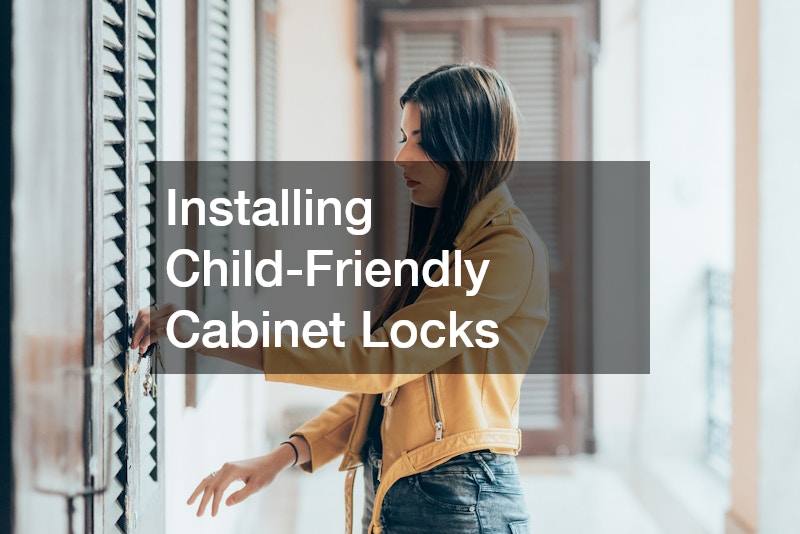Goal Remodeling
When it comes to creating a safe environment for your children, every part of your home plays a critical role in ensuring their well-being. Child-proofing a house requires thorough attention to detail and the use of effective home remodeling resources. Whether you’re protecting young ones from sharp corners, slippery floors, or dangerous electrical outlets, knowing what tools and services are available can make the process far smoother. Child-proofing isn’t just about adding temporary fixes; it often involves long-lasting changes that improve the overall safety of your home. By tapping into the right home remodeling resources, you can create a space that’s both comfortable and secure for your family. Whether it’s something as simple as choosing the right cabinet locks or more comprehensive changes like upgrading your home’s foundation, the right resources can make all the difference in ensuring a child-safe home.

Identifying High-Risk Areas in Your Home
Before diving into the remodeling process, it’s crucial to assess the high-risk areas in your home where accidents are more likely to happen. Kitchens, bathrooms, and living rooms are often hotspots for injuries due to their frequent use and potential hazards like slippery surfaces or sharp objects. It’s important to review each room, taking note of potential dangers, including heavy furniture, electrical outlets, or unstable areas, such as the stairs. Identifying these areas will help you prioritize where you need to apply child-proofing solutions.
More specifically, home foundation contractors can play a significant role in this process by addressing underlying structural issues. If your home’s foundation is uneven or compromised, it can create an unstable environment that poses a risk to children. Correcting foundational problems can help eliminate tripping hazards, uneven floors, and the shifting of furniture that could harm a child.
Selecting Safety Gates for Staircases
One of the most common ways to child-proof a home is by installing safety gates at the top and bottom of staircases. These gates serve as barriers to prevent children from accessing stairs without supervision, minimizing the risk of falls, which is one of the leading causes of injury in homes with young children. When selecting the right gate, it’s important to consider factors such as material, height, and durability. You want to choose a gate that is sturdy enough to withstand pushing or pulling, and that has a locking mechanism that is child-proof but easy for adults to operate. Home remodeling resources can help guide you through the options available, from pressure-mounted to hardware-mounted gates, ensuring you find a solution that fits your home’s layout and your specific safety needs.
In some cases, working with fence building professionals can help you design custom gates that fit the unique dimensions of your home’s staircases. These experts can create gates that not only enhance the safety of your home but also complement your interior design. For families with more complex or wider staircases, or homes with multiple levels, having a custom solution from a fence-building professional ensures that all access points are effectively secured.

Installing Child-Friendly Cabinet Locks
Cabinet locks are an essential part of child-proofing a home, particularly in areas like the kitchen and bathroom where cleaning products, sharp objects, or other hazardous materials are stored. Installing child-friendly locks ensures that curious toddlers can’t access dangerous items that could harm them. There are a variety of options available, from magnetic locks to strap locks, each designed to prevent small hands from opening doors or drawers. These locks are easy to install and use but are strong enough to withstand attempts by young children.
When it comes to more technical installations, HVAC contractors can assist in securing access to dangerous equipment like heating and air conditioning units. Ensuring that cabinet locks or secure covers are placed on utility closets or any areas where HVAC systems are stored is critical for preventing accidents. HVAC contractors can help identify parts of the system that should be kept out of reach and provide child-proofing solutions that will enhance safety while maintaining the functionality of your home’s heating and cooling systems.
Choosing Non-Slip Flooring Solutions
Slips and falls are a leading cause of injury among children, especially in areas like kitchens, bathrooms, and playrooms. Installing non-slip flooring is a practical and effective way to reduce the risk of these types of accidents. Materials like rubber, textured vinyl, or specially designed mats can provide additional traction, making floors safer for children who are just learning to walk or who tend to run around the house. Home remodeling resources can guide you through various non-slip options, helping you select materials that blend with your home’s design while providing maximum safety.
For outdoor areas such as driveways and play zones, working with an asphalt contractor can enhance child safety by applying non-slip coatings or resurfacing areas that have become cracked or uneven. Outdoor spaces often get overlooked in child-proofing efforts, but ensuring they are just as safe as your indoor floors is crucial. An asphalt contractor can provide resurfacing services to make sure that all walkways, driveways, and patios are safe for kids to play on without the risk of tripping or slipping.

Securing Furniture and Appliances Properly
Large furniture and appliances pose a significant risk to children, especially those who like to climb. Securing items like bookshelves, televisions, and refrigerators to the wall can prevent them from tipping over and causing serious injuries. Anchor straps and brackets are widely available and can be installed easily to keep heavy objects in place. Home remodeling resources can offer advice on the most effective ways to secure furniture and appliances, ensuring they remain stable even if a child attempts to pull or climb on them.
For appliances and electronics that require more secure installation, working with an electrical installation expert can be beneficial. Large items like wall-mounted televisions, microwaves, and ovens need to be safely wired and installed to avoid both electrical hazards and instability. An electrical installation expert can ensure that all appliances are not only securely fastened but also connected to the electrical system in a way that minimizes risks to children, ensuring that your home is both functional and safe.
Upgrading Electrical Outlets for Child Safety
Electrical outlets are often at eye level for crawling babies and toddlers, making them a major safety hazard. Upgrading your outlets with child-proof covers or tamper-resistant receptacles is an essential step in any child-proofing plan. Tamper-resistant outlets are designed to prevent children from inserting objects into them, reducing the risk of electric shocks or burns. You can also consider sliding outlet covers that automatically close when not in use. Home remodeling resources can help you find the best outlet safety options for your home, ensuring that all outlets are properly protected while maintaining the functionality of your electrical system.
For a more comprehensive upgrade, working with an electrical contractor is highly recommended. Electrical contractors can inspect your home’s wiring and outlets, recommending additional safety measures like installing ground fault circuit interrupters (GFCIs) in areas prone to moisture, such as bathrooms and kitchens. These upgrades, performed by an experienced electrical contractor, ensure that your outlets are not only child-safe but also comply with modern electrical safety standards, providing peace of mind for parents.

Utilizing Window Guards and Stops
Windows can present a danger to young children, especially on upper floors. Utilizing window guards and stops can help prevent falls, which are a common hazard in homes with accessible windows. Window guards are metal or mesh barriers that can be installed over windows, while stops prevent windows from opening more than a few inches, allowing for ventilation without the risk of a child falling through. Home remodeling resources can guide you in selecting the right guards and stops for your windows, ensuring that they are both secure and easy to use for adults while providing a critical layer of protection for children.
In addition to securing the windows, consulting with a roofing contractor can help ensure that any skylights or roof access points are similarly protected. Roofing contractors can install protective barriers or secure access points to ensure that curious children cannot reach dangerous areas. By taking these extra steps, particularly in homes with multiple stories, you can create a safer environment, both inside and outside, for your children.
Selecting Safe Paint and Finishes for Walls
When child-proofing your home, it’s important to consider the materials you use on your walls and other surfaces. Selecting safe, non-toxic paint and finishes is a key step in reducing your child’s exposure to harmful chemicals. Many conventional paints contain volatile organic compounds (VOCs), which can release toxic fumes long after the paint has dried. Opting for low-VOC or zero-VOC paints is a safer choice for homes with young children, as these products have fewer harmful chemicals and are often more environmentally friendly. Home remodeling resources can point you toward safer, non-toxic options for painting and finishing your walls, making your home both aesthetically pleasing and safe for your family.
In addition to selecting safe materials inside the home, it’s also essential to consider outdoor safety. Working with tick control experts can help create a safer outdoor environment for children, as ticks often carry harmful diseases. By applying safe and effective pest control measures around your yard and garden, you can reduce the risk of your children coming into contact with ticks, further enhancing the safety of your home’s environment.
Ensuring Safe Bathroom Remodeling Features
Bathrooms are one of the most dangerous areas in the home for young children due to the combination of water, slippery surfaces, and sharp edges. When considering child-proofing through bath renovations, it’s important to focus on safety features such as non-slip tiles, rounded edges on counters, and secure fixtures. Installing anti-scald devices on faucets and showerheads can also prevent burns from hot water. Additionally, consider installing child-proof locks on cabinets and drawers to keep harmful substances, like cleaning supplies or medications, out of reach. Home remodeling resources can guide you toward bath renovation options that prioritize both safety and functionality.
For more specific projects, bath renovations can include installing lower bathtubs or shower areas with handrails to make bath time safer and more manageable. Renovations might also focus on reducing sharp corners and edges, which can be particularly dangerous in a wet environment where slips are more likely. These types of targeted renovations ensure that your bathroom is both child-friendly and functional for the entire family, making it a safer environment for young children.
Incorporating Soft Edges and Corners
One of the simplest yet most effective ways to child-proof a home is by incorporating soft edges and corners on furniture and fixtures. Items like coffee tables, countertops, and shelving units can pose a serious risk to small children learning to walk or run. Installing corner guards or opting for furniture with rounded edges can greatly reduce the likelihood of injury. There are a variety of home remodeling resources available that offer child-safe furniture options or add-on products to soften the edges of existing pieces, making your home more kid-friendly without sacrificing style.
Outside the home, you can work with a hardscaping contractor to ensure that any outdoor play areas or patios are also safe for children. For example, hardscaping contractors can help create soft, rounded edges on garden walls, pathways, or outdoor seating areas, reducing the risk of injury during outdoor play. By integrating soft edges and corners both inside and outside your home, you create a safe environment where your children can explore without the constant fear of bumps and bruises.
Maintaining New Safety Precautions
Child-proofing your home is a crucial step in ensuring the safety and well-being of your children. By utilizing a wide range of home remodeling resources, you can address potential hazards in every part of your house, from the bathroom to the backyard. Whether you’re securing heavy furniture, upgrading electrical outlets, or installing non-slip flooring, taking proactive measures helps create a safe environment for your family to thrive. Many of these projects require collaboration with professionals such as electrical contractors, bath renovation experts, and hardscaping contractors, who bring specialized knowledge to ensure both safety and compliance with industry standards.

